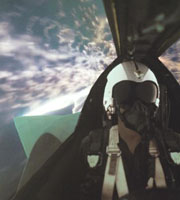 |
 |
 |
 |
 |
||
Lightning and Flight |
||||||
|
|
||||||
|
A thunderstorm can be a pilot's worst nightmare. Thunderstorms can cause delays in flights because pilots need to avoid their dangers. Airports also need to protect their ground crews that are getting baggage loaded and planes ready for take off and landing. After you read the information here test what you have learned by taking the Lightning and Flight Quiz. How
can pilots avoid a thunderstorm or lightning?
But planes can't always avoid lightning. Lightning can strike miles away from the thunderstorm. Sometimes, in fact, an airplane that flies into a cloud that already has electrical charges built up in it can create a lightning stroke. What
are the dangers of a thunderstorm to a plane?
Can
Lightning strike a plane?
What
has been done to keep planes safe from lightning? Many planes have their outer areas (called skins) made from aluminum. This is a metal that is a very good conductor of electricity. If lightning strikes the plane, most of the lightning current remains on the exterior of the aircraft and flows along the exterior and then away from the plane. Newer airliners are being made of composites which do not conduct electricity as well, but the outer skin is embedded with a layer of conductive fibers designed to carry the lightning currents. Systems have been designed to help protect all of the computers and instruments that control everything in the airplane. Lightning protection engineers make sure that damaging surges can not reach the equipment inside the aircraft. Shielding, grounding and surge suppressions devices are used to help protect cables, circuits, and equipment. Every piece of equipment that is essential to a safe flight and landing of an aircraft must be tested and certified that it is protected against lightning. The Federal Aviation Administration (FAA) sets the standards and put the regulations in place. In addition, we now have more sophisticated instruments to help detect lightning and predict weather conditions. Doppler radar is weather radar that measures the direction and speed of a moving object, such as drops of precipitation. This can help those in the airport's flight control centers know where the storms are located. Lightning detection networks have also been developed which can track lightning strikes all over the country using the National Lightning Detection Network. This network uses magnetic sensors and computers to detect when and where lightning strikes. If a supercell (the most dangerous type of thunderstorm) is spotted, pilots and airport personnel are alerted Even though the passengers and crew may see a lightning flash and hear a noise if lightning strikes their plane, nothing serious should happen because of the lightning protection built into the aircraft. Pilots sometimes report a temporary flickering of cabin lights or some brief interference with their instruments. Smaller planes are probably struck less frequently by lightning because of their small size and because they often avoid weather that might include severe thunderstorms and lightning. Larger airliners may delay flights to protect passengers and flight crew as well as ground crews that are handling baggage or preparing planes for departure. Once in the air, pilots often fly detours or change altitude to avoid severe storms and the turbulence or lightning. |
Has
a plane that was struck by lightning ever crashed? By studying these crashes scientists can find ways to keep similar problems from happening again. The crash in Maryland was caused by lightning creating a spark that ignited fuel vapor in the plane's tank. Finding this out led to rules that required airplanes to have built-in-systems to keep sparks from reaching and igniting the fuel or fuel vapors.
|
|||||





